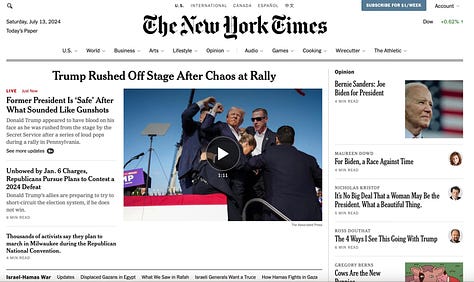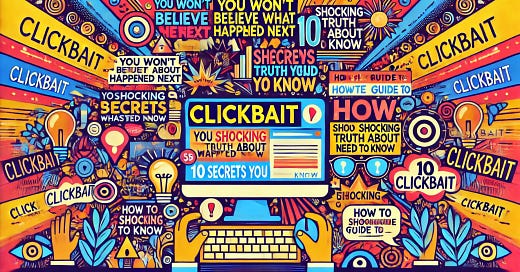Welcome to Polymathic Being, a place to explore counterintuitive insights across multiple domains. These essays take common topics and explore them from different perspectives and disciplines, to uncover unique insights and solutions.
Today's topic addresses the highly effective nature of clickbait headlines and how headlines in general prime us for a certain viewpoint. Join us as we explore the effects of priming and how we can mentally check ourselves to avoid that priming.
Intro
A few weeks ago I posted a funny picture with a simple caption. This was right after a couple weeks of rough politics, the assassination attempt on Trump, and more. People were primed for negativity and expecting the worst. Based on it’s virality, people online also needed some levity.
Some of my favorite comments include those who took the idea and ran with it.
Even better were the people who saw the ridiculousness of it, the sheer juxtaposition of a week of chaotic news, and got a very needed laugh out of it.
This is the power of priming. It’s all around us in every headline and in all of the newscasts. We are given a snippet and told what to think. This, in itself, isn’t a problem. This post, and comedians in general, use priming in the bait and switch, the deflection, and the punchline. Extra credit if there’s a double entendre.
My post keyed into two biases and stereotypes:
Angry - News that week was, and had been, pretty negative.
Post - On a social media platform we all know what a post means.
Then I anthropomorphized an actual post and voila, priming pivot to joke and people loved it. Jokes use priming for comedic effect and are pretty innocuous but what happens when people hijack priming for more nefarious outcomes?
Negative Priming
"10 Secrets You Need to Know About [Topic]"
"You Won’t Believe What Happened Next"
"This One Trick Will Change Your Life Forever"
"The Most Unbelievable Story You'll Ever Read"
"5 Out of 6 People Are Doing This Wrong"
"90% of People Don’t Know This About [Topic]"
These are called clickbait. They’re designed to trigger your innate desires for salacious news, the drive to be better, to not be wrong, to flaunt your intelligence, to align with your tribe, and more. And to what end?
A lot of the time they’re just harvesting your interactions to boost traffic and ad revenue. In fact, those silly little things on social media often farm your ‘likes’ and shares and then sell those interactions to other pages to bolster their ratings! However, on a more negative side, they’re used to collect personal information or identify targets for exploitation. This example is an image prime using clearly AI-generated imagery with the trigger: “Why don't pictures like this ever trend”


The thing is, they DO trend and when you look they’ve got thousands of likes and hundreds of shares and they keep popping up in my Facebook feed! So clearly the priming is working and triggering the desired outcome.
Another example is The Drudge Report which is infamous for priming headlines. They don’t write the articles; they just rewrite the headlines. When you click any links, you’ll be taken to the original article, but already primed for their desired outcome. Even better, don’t read the article, just scan the headlines and walk away with the interpretation of the world they want you to have. How many priming words do you see?
I’ve poked at two conservative examples but look at the coverage of the attempted assassination of Trump by some well-known media outlets. These headline-priming words read as: Trump attended a chaotic rally, was startled by loud noises and fell down. What a wimp! Especially after all the attacks on Biden’s frailty. Who’s he to talk?



People don’t read past the headlines 90% of the time, and first impressions matter. I faced this with a YouTube video I made about how AI tools work with writing my novel. The original title was “AI as a Co-writer.” I recently changed it to “Writing and AI: Limitations and Capabilities of Emerging Tech” because people were shaming me about AI though they never watched the clip!
Taking Action Against Priming.
First thing, acknowledge that priming and clickbait work!
A trick I’ve learned is to read a headline or a caption and then go back and look for the intentional priming words. Where are they directing me and did I follow their lead? Can I go back and shift the perspective by changing the priming words?
This is especially important for the topics you agree with because we all love confirmation bias and priming also targets that in spades. You’ll always see ‘their’ clickbait but you rarely see your own.
Now let me show you a great example of challenging the priming as
and show here in reply to my ‘angry’ post:Is this post angry or is it proudly standing with hands on hips?
In The Enemy’s Gate is Down, we talk about the power of intentionally reframing and I think this is a perfect example of that. Now, let me help out a little bit and see just how much different I can make the priming with a new post:
Whoa! That’s not the same post at all! This is now a confident post with poise, dedication, and resolve. This post serves humanity by facing the future and protecting others from negative clickbait! This entire paragraph is also chock full of priming words to cement that impression.
And it works.
Conclusion
Priming is a powerful tool that we need to be aware of. It can be innocuous. It can be useful. It can also lead us to places others want us to be. It can lead us to places we don’t want to be. The key is to hone our conscious review of our priming, especially if it confirms our own biases and stereotypes. This is where we are all the most susceptible to negative manipulations.
You don’t have to let them control you. You have the agency to adapt your priming to angle toward a better position. This is the real truth they don’t want you to know. 😀
And for those keeping count, this is a post about a post of a post. I just can’t wait to post this to other social media! It’s becoming meta!
For more information about the biases and stereotypes priming leverages, please check out the essays, “Stereotyping Properly,” and “Eliminating Bias in AI/ML”
Enjoyed this post? Hit the ❤️ button above or below because it helps more people discover Substacks like this one and that’s a great thing. (and it helps train your algorithm) Also please share here or in your network to help us grow.
Polymathic Being is a reader-supported publication. Becoming a paid member keeps these essays open for everyone. Hurry and grab 20% off an annual subscription. That’s $24 a year or $2 a month. It’s just 50¢ an essay and makes a big difference.
Further Reading from Authors I Appreciate
I highly recommend the following Substacks for their great content and complementary explorations of topics that Polymathic Being shares.
- All-around great daily essays
- Insightful Life Tips and Tricks
- Highly useful insights into using AI for writing
- Integrating AI into education
- Computer Science for Everyone











Great article. The NY Times published an article, around 2018 I think, in which it reported research that the headline of an article not only frames how people read the article, but even what they remember from reading it.
Would AI make priming more sophisticated and more challenging to detect? I think the answer is yes.
We cannot easily overcome biases, and reading widely (both in favor and against before we form any opinions about a topic will be a necessary skill) and applying critical thinking will be the key to overcoming priming in the future.